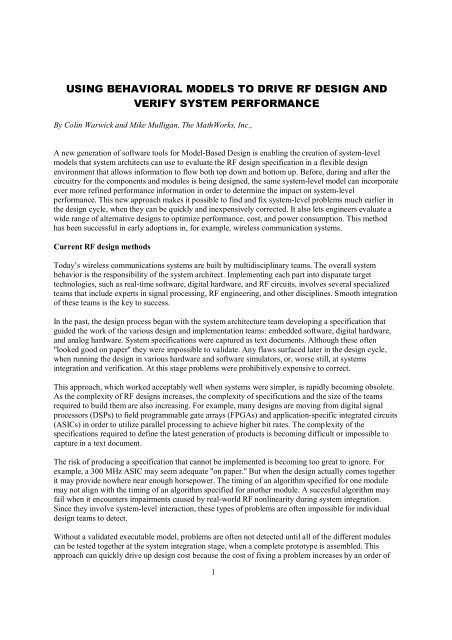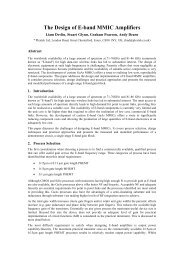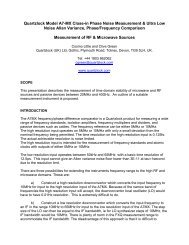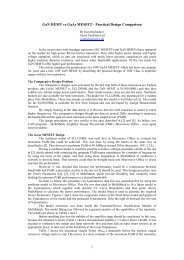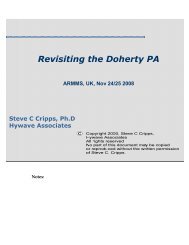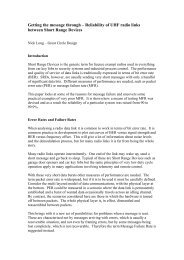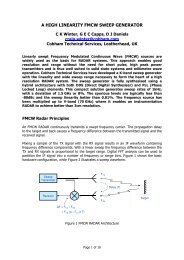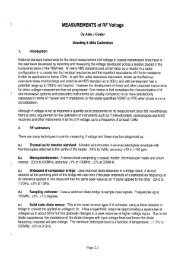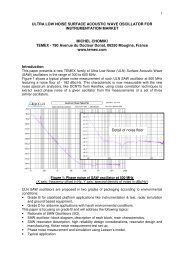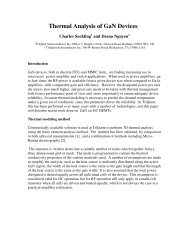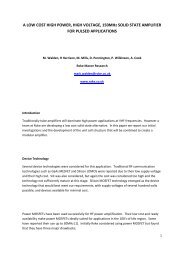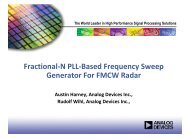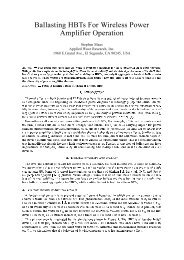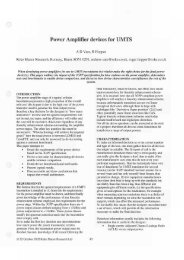using behavioral models to drive rf design and verify system ...
using behavioral models to drive rf design and verify system ...
using behavioral models to drive rf design and verify system ...
Create successful ePaper yourself
Turn your PDF publications into a flip-book with our unique Google optimized e-Paper software.
Figure 3: Under the <strong>to</strong>p-level "RF Receiver" block is a receiver model created from four componentblocks <strong>and</strong> four inte<strong>rf</strong>ace blocks.The Input <strong>and</strong> Output Port blocks mark the transition from the signal processing domain (where thebaseb<strong>and</strong> in-phase <strong>and</strong> quadrature rails are represented as real <strong>and</strong> imaginary parts of a complex timedomainsignal) <strong>to</strong> the RF domain (which is specified in terms of the frequency-domain properties ofcomponents acting on a real passb<strong>and</strong> signal). As mentioned above, in the RF domain we can use amathematical transformation <strong>to</strong> transform the frequency range of interest (a b<strong>and</strong> around the cente<strong>rf</strong>requency) <strong>to</strong> its baseb<strong>and</strong> complex equivalent. This affords faster simulation speed.In Figure 3, the first block after the input port is the S-parameters Filter block, followed by an RFamplifier, mixer, <strong>and</strong> IF amplifier blocks. The amplifiers are defined by S-parameters, noise figure, <strong>and</strong>third-order intercept point (a simple way of expressing nonlinearity). One specifies additional parametersfor the mixer block: phase noise, LO frequency, <strong>and</strong> so on. Because the LO is conceptually "built-in" <strong>to</strong>the mixer block, only the two remaining ports (RF <strong>and</strong> IF) are depicted in Figures 3 <strong>and</strong> 4(a <strong>and</strong> b).Figure 4a.6
9 - COMPTE DE RESULTAT PREVISIONNELL I B EL L E 1 ère ANNEE 2 ème ANNEE 3 ème ANNEEChiffre d'affaire prévisionnelAutres produits• ................................................................................• ................................................................................Sous-Total (1)CHARGES D'EXPLOITATION• Masse salariale• Charges sociales• Assurance• Carburant• Entretien, réparation• Autres travaux et fournitures• Publicité, promotion• Autre frais de gestion• Impôts et taxes (Patentes, …)• Amortissement• Frais de location de services à d'autres transporteurs• Frais financiers (intérêts d'emprunt)• Autres (préciser)• ................................................................................• ................................................................................Sous-Total (2)Résultat de l'exercice (1 - 2)10 - MODE DE COMMERCIALISATIONDénomination des contactsprofessionnels entrepris (<strong>to</strong>ursopérateurs, agences de voyage,hôtels, bateaux de croisière)Moyens promotionnels Accords ou contrats commerciauxengagés et envisagésSupports Budgets Date de délivrance En cours denégociation11 - TYPE DE CLIENTELE VISEE :Résidents Touristes Bateaux de croisière HôtelsAutres (préciser) ........................................................................................................................................................................................................................................................................................................................................................................................................................................................................................................................Page 7 sur 8
In our example, the simulation showed that the initial concept <strong>design</strong> introduced noise <strong>and</strong> nonlinearitiesin the front end that made it impossible <strong>to</strong> meet the 802.11a specification. The initial <strong>design</strong> provided amaximum of 12 <strong>to</strong> 18 MB/s throughput instead of the required 54 MB/s. This type of result provides the<strong>system</strong>s architect with the information that he or she needs <strong>to</strong> improve the specification. At this stage, the<strong>system</strong> architect typically runs a parameter sweep on the receiver components over a range of gains <strong>and</strong>noise figures in an effort <strong>to</strong> balance the gain produced by each stage against the noise it introduced <strong>and</strong> <strong>to</strong>develop a workable set of specifications for each component. This is the classic problem of optimizing thegain distribution. If there is <strong>to</strong>o much gain early in the cascade before filtering, intermodulation productswill limit pe<strong>rf</strong>ormance. Too little gain early in the cascade <strong>and</strong> noise becomes the limiting fac<strong>to</strong>r. For each<strong>design</strong> iteration, the <strong>system</strong> architect simulated the model <strong>to</strong> calculate the receiver sensitivity, providingresults that not only validated the specification but also helped <strong>to</strong> underst<strong>and</strong> its sensitivity <strong>to</strong> various<strong>design</strong> parameters. In this way, the gain distribution was optimized with respect <strong>to</strong> noise <strong>and</strong> nonlinearity.The <strong>system</strong> architect could at this point h<strong>and</strong> off a set of specifications for each component <strong>to</strong> the RFteam.Later in the project, the <strong>system</strong> architect may have a short list of c<strong>and</strong>idate components <strong>to</strong> <strong>verify</strong>, eithergeneral-purpose or application-specific st<strong>and</strong>ard products from a semiconduc<strong>to</strong>r vendor's catalog orcus<strong>to</strong>m-built circuits from the RF engineering team. In this case, the general circuit element block makesit possible <strong>to</strong> swap out one or more placeholders at a time, <strong>and</strong> import components based on powersweeps of either measured data or circuit simula<strong>to</strong>r runs (Figure 5). The modeling environment providesthe ability <strong>to</strong> plot the network parameters <strong>to</strong> a polar plane or Smith chart that can be used <strong>to</strong> confirm thatthe correct data has been imported (as Figure 6 shows).8
Figure 5: Blocks can be substituted with different blocks from the library as the <strong>design</strong> is refined.With this combination of real components <strong>and</strong> placeholders, we can simulate the receiver <strong>and</strong> compare itspe<strong>rf</strong>ormance <strong>to</strong> an ideal gain block <strong>to</strong> <strong>verify</strong> its pe<strong>rf</strong>ormance in terms of linearity, noise <strong>and</strong> networkcomponents against the <strong>system</strong>-level metrics such as throughput <strong>and</strong> bit error ratio versus path loss.9
Figure 6: After the placeholder amplifier is replaced by a model specified by measurement data, thecharacteristics are visualized.ConclusionThis example illustrates how Model-Based Design makes it possible <strong>to</strong> develop specifications in a teamenvironment where they can be evaluated based on cost, pe<strong>rf</strong>ormance, power consumption, <strong>and</strong> otherobjectives. The <strong>system</strong>s architect creates <strong>and</strong> communicates the RF specification in the form of a<strong>behavioral</strong> model that can be used <strong>to</strong> validate the specification against requirements before it is turnedover <strong>to</strong> the RF <strong>design</strong> team. The same model is refined during the subsequent <strong>design</strong> process <strong>to</strong>incorporate results generated by the RF engineers who are creating the actual circuit <strong>design</strong>. The RFengineers pass back <strong>behavioral</strong> information from their EDA <strong>to</strong>ols <strong>and</strong> test data <strong>to</strong> <strong>verify</strong> <strong>system</strong>-levelpe<strong>rf</strong>ormance early in the process.For example, the RF engineer may not be able <strong>to</strong> achieve the specification for a certain component withinthe given cost constraints. The <strong>system</strong>s architect can modify the model <strong>to</strong> use an economical, achievablespecification, determine the impact on the <strong>system</strong> pe<strong>rf</strong>ormance, <strong>and</strong>, if necessary, make compensatingadjustments <strong>to</strong> the specifications of other components, such as <strong>using</strong> signal processing <strong>to</strong> mitigate theimpairment. This process makes it possible <strong>to</strong> identify, diagnose, <strong>and</strong> correct <strong>system</strong>-level problems at amuch earlier stage than is possible with a more traditional development process. The net result is thatproblems can be identified <strong>and</strong> fixed more efficiently <strong>and</strong> <strong>system</strong>-level tradeoffs can be evaluated moreeasily in order <strong>to</strong> increase pe<strong>rf</strong>ormance <strong>and</strong> reduce cost.10


